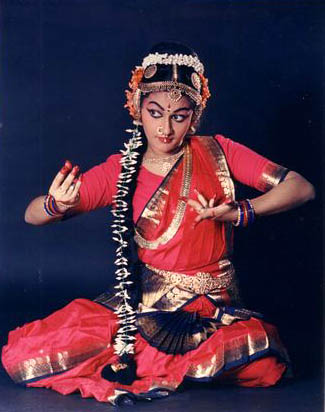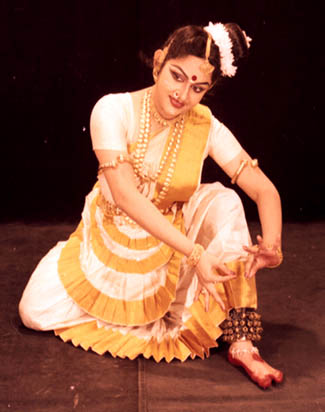
About
Sanjukta Banerjee is an Indian Classical dancer and educator specializing in Bharatanatyam and Mohiniyattam. An empanelled dancer with Indian Television, Eastern Zonal Cultural Centre and Sangeet Natak Academy, she has extensively toured all over India, Middle-East, South-eastern countries of Asia, Europe, USA and North America. Sanjukta has performed in various major Dance and Theatre Festivals all over India. Sanjukta has gained wide acclaims for her performances of "Durga" for Doordarshan on the occasion of MAHALAYA for National Network Indian Television since1994 to 2014 and also in the role of Draupadi in Mahabharata dance drama for NABC' 2013. Artistic Director of Saugandhikam Dance Academy, she conducts classes in Toronto and Mississauga, also offers Skype/online lessons of dance. She is currently pursuing Doctoral studies at Dance department of York University, Toronto with research interests in gendered bodies and reenactment of movements in traditional repertoires.
Training & Educator:
• Master of Arts, Dance, York University, 2015.
• Master of Arts, English Literature, Calcutta University.
• Guru /Teachers of Bharatanatyam and Mohiniyattam, Dr. Thankamani Kutty, Kalamandalam
• Kathakali – Late Guru Kalamandalam.P. Govindan Kutty.
• Artistic Director of Saugandhikam Dance Academy, Kolkata, Toronto.
• External Examiner for Undergraduate & Graduate Degree programs in Rabindra Bharati University, Kolkata.
• Judge for State & National level Dance competitions.
• Offered courses/Lecture-demonstrations/workshops in Universities on Bharatanatyam, India, Lebanon, Canada & US.
Scholarship:
• Sanjukta has received scholarship in her Master’s program of Dance at York University.
• Senior Research Scholarship, by Dept. of Culture, Govt. of India in MOHINIYATTAM.
Awards:
• ‘Natya Kala Rathna’ Title by Regatta Kala Kendra and NKK, Toronto, 2015.
• "Outstanding Young Person '97” by North Calcutta Junior Chamber, Kolkata,1997.
• "CCI" award '97 by Critic Circle of India, New Delhi,1997.
• "Singar Mani" title awarded by Sur Singar Samsad, Mumbai, 1999.
• Jadubhatta Purashkar '95 by Salt Lake Music Conference, Kolkata, India,1995.
Prominent Stage appearances:
• 37th Dover Lane Music Conference. Kolkata, 1989.
• Diamond Jubilee Celebrations of Kerala Kalamandalam, Trichur 1990, Calcutta, 1991.
• Youth Festival, Calcutta 1990.
• 3 - City Dance Festival (Org.: ITC) in Vishakhapatnam, Patna, Lucknow in 1991.
• International Festival of Performing Arts, Beirut, Lebanon, 1994.
• Salt Lake City Music Conference, in Calcutta 1994 and 1995.
• Vasanta Utsav (Org.: EZCC) Burdwan, W.B. - 1997 and 1998.
• Kal Ka Kalakar (Org.: Sur Singar Samsad), Mumbai 1998.
• Haridas Sangeet Sammelan, Mumbai 1999.
• Bhakti Kala Kshetra (Org.: ISKCON), Mumbai 1999.
• India International Centre, New Delhi 1999.
• Udayshankar Dance Festival, Kolkata,1996,1998,2000, 2001,2014.
• Konark Festival, Orissa 2000.
• Indian Classical festival, Kuwait, Qatar, Doha, 2000.
• Swarna Nritya Pratibha, Sangeet Natak Academy, Delhi, 2004.
• Darjeeling Carnival org. by ICCR, EZCC, Russian Consulate, 2005.
• All India Women’s' Conference, EZCC, Kolkata, 2006.
• National Centre for Performing Arts, Mumbai '2006.
• Rabindra Jayanthi Celebrations, Singapore, 2006.
• Epar Bangla-Opar Bangla,WMBA, Michigan, 2008.
• World language Day, University of Lansing, 2010.
• Indian festival, Saugatuck Performing Arts, Michigan, 2011.
• 33rd North America Bengali Conference, Toronto 2013.
• Dundas Square, Indian Consulate, Toronto 2013.
• Toronto Islington-Albion Festival, 2013.
• Follow- Me TV launching Ceremony, Toronto 2014.
• Inspirations 2013, sponsored by Toronto Arts Council, 2013.
• Dancing Damsels Festivals, Toronto, 2014
• Durga Puja celebrations, Michigan, St. Louis, Omaha, New York, Cleveland, Toronto. Screen Appearances:
• An empanelled classical dancer of Indian Television, Doordarshan, India
• An empanelled dancer of Cultural Dept. Govt. of India.
• She has gained wide acclaims for her un-daunting performances as "Durga" for National Network Indian Television from 1994 -2004, which is a record by itself.
• She has been cast in the role of "Durga" for special transmission on the occasion of Mahalaya on the birth centenary of Dr. Birendra Krishna Bhadra for National Network transmission in 2004.
• Participated in film director Gautam Halder's award winning documentary on the great tabla maestro Hiru Ganguly, 1994.
• Participated in documentary "Searching for Happiness" produced by German television on India in 2004.
Conference Presentations:
• ICONDE 2014, University of Malaya, Kuala Lumpur.
• Dance Transition Resource Centre 2016, “On the Move”, Sony Centre for the Performing Arts, Toronto.
• 15th Art History Symposium 2016, York University, Toronto.
• International Federation for Theatre Research 2016, Presenting the Theatrical Past, Stockholm, Sweden.




 Bharatanatyam
Bharatanatyam Mohiniyattam:
Mohiniyattam: